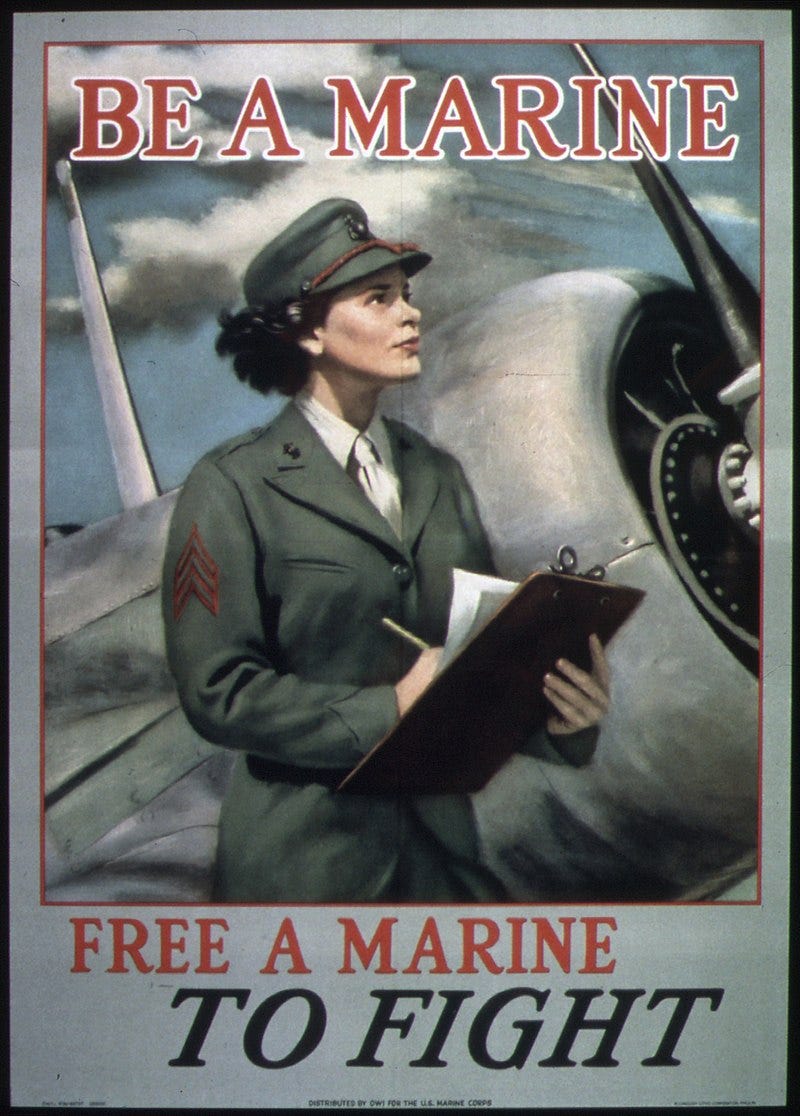TDIH: Marine Corps Women's Reserve
Women served in every branch of our military during World War II, but the Marine Corps went a step further.
On this day in 1943, Mrs. Ruth C. Streeter is commissioned as a Major in the United States Marine Corps. She would serve as the first director of the newly formed Marine Corps Women’s Reserve.
Women served in every branch of our military during World War II, but the Marine Corps went a step further: These women didn’t merely serve in some sort of auxiliary service, as women in the Navy, Army, or Coast Guard did.
They were full-fledged Marines.
The Commandant of the Marine Corps, General Thomas Holcomb, had been slow to accept women, but he soon realized that he needed them: Their service would free up men to serve overseas. Thus, he turned to Virginia C. Gildersleeve, Dean of Barnard College, for help. She’d led a committee that found a director for the Navy’s WAVES. Now, she would help the Marines find their new director, too.
Mrs. Ruth C. Streeter was chosen for the job. She was a commercial pilot who was also known for her work in the community. Mrs. Streeter was sworn into her new role on January 29, 1943. The creation of the Women’s Reserve was announced to the public a few weeks later, on February 13.
The response was overwhelming. Recruiting offices were swamped with volunteers. Some were widows of Marines who had already been killed in combat. One woman would explain that she joined the Marines because “my brother would come home from the war sooner if I did.”
Some women were deemed underweight and unable to serve, but they gorged on bananas and returned for a second weighing. Others tried to enlist even though they weren’t technically old enough—some of these even had the support of their parents.
“As I have no sons to give to the Marines,” one World War I veteran wrote, “I would be more than happy if you . . . would recommend my daughter to the newly-formed Marines Women Reserve Corps. While I appreciate that her age may be a little young, she will be 18 this June. . . . surely this is not too much for a D.S.C. ex-Marine to ask of you.”
Some members of the public submitted suggestions for a nickname for the Women’s Reserve. If the Navy women could be called WAVES, then why not call women in the Marines MARS, Femarines, or Marinettes? But General Holcomb was adamant. There would be no nickname. These women were, quite simply, Marines.
“They don't have a nickname, and they don't need one,” he said. “They get their basic training in a Marine atmosphere, at a Marine Post. They inherit the traditions of Marines. They are Marines.”
The women Marines soon showed their worth, acting as aviation mechanics, radio operators, and cryptographers. They loaded bombs and learned to fire machine guns.
These women made their nation—and the Marines—proud.
“Well, I'll tell you,” one Corporal reportedly said. “I was kinda sore about it at first. Then it began to make sense—though only if the girls are gonna be tops, understand.” His friend retorted: “Hell, they’re gonna be Marines, aren’t they? They gotta be tops!”
And so they were. Even General Holcomb was forced to admit that his initial reluctance had been wrong.
“Like most other Marines, when the matter first came up,” he later said, “I didn’t believe women could serve any useful purpose in the Marine Corps . . . Since then I’ve changed my mind.”
Semper Fi, Marines.
Sources can always be found on my website, here.





A BIG "THANK YOU" to these Ladies and ALL who seved this nation!
Women sworn and trained to serve in the Corps should be entitled to the title of Marine. I was proud to serve with women of the Navy and the Marines and their training qualified them to fulfill their duties and responsibilities. I have great respect for women and men who serve our great nation. Thank you Tara.